The Film: Batman: Gotham Knight(2008)
The Principles: Greg Rucka, Brian Azzerello,David S. Goyer, Jordan Goldberg(Writers) Will Friedle, Kevin Conroy, Gary Dourdan
The Premise: An anthology dealing with various events over a single night with Gotham’s notorious defender and the outlook of those he comes into contact with.
Is It Good: This is not nearly as good as Batman Beyond: Return of the Joker , Batman: Mask of Phantasm or Batman: Under the Red Hood, but it shines in ways that the others don’t. Yesterday I covered Batman Beyond: Return of the Joker as a great example of superb character definition by the creative team of Paul Dini and Bruce Timm, and today I am continuing to cover additional character definition from a lesser known direct to video animated film, but this one almost completely ignores Bruce Wayne and works around how others view the Batman in the city of Gotham.
Each of the stories has their own narrative, jumping around the timeline and point of views. The animation and creative teams switch with each segment. The thing of note is that two of these stories are penned by popular Batman comic writers. Greg Rucka’s story in particular is a moving version of characters he has been so popular with in various comic series.
The first of the stories deals with some kids at a skate park trying to one up each other with tales of their personal run ins with the legendary Batman. As with so much of Gotham as defined first in the comics and later in Nolan’s universe, Batman is a thing of myth and legend. He is a story told between people, letting them turn him from a teched out human into something that cannot possibly be real. As each kid describes the way Batman appeared to them, the villain evolves as well. The artwork here reminded me of a cross between some of the comic art I disliked the most (Legends of the Dark Knight 55-57) and Sam Keith, who was very abstract but also stunningly beautiful at the same time. This becomes a strong point as the art matches the abstract opinions and stories of the kids at the park.
The thing that stands out the most as far as definition goes, is that these are regular kids talking about a myth. One says he was an apparition and the others say no that can’t be true. The dialogue sounds genuinely like a bunch of teens discussing a fight at school. Each of them would see something different, even though they all truly saw the exact same thing. During the War Games crossover events in the Batman comics, Commissioner Akins told the police to arrest Batman on sight. This made him public enemy number one, even though a lot of the cops would turn a blind eye, he hid from all of them and acted like he was a wanted man. He remained in the shadows, rarely seen by anyone, and turned into a complete legend. Such as the end of The Dark Knight he became “what Gotham needs”. A fairy tale whispered in the darkest corners of a dark city, scaring would be criminals away from crime and giving children like these something to talk about.
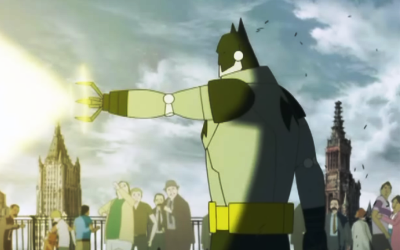
The second story is my favorite out of the 6, and upon first watch I never even paid attention to who wrote it. When I was preparing for this column I asked myself how ignorant could I have been not to recognize one of my preferred comics writers utilizing a character he first gave life to. Crispus Allen was one of the main components of the ensemble comic series, Gotham Central. Rucka first created the character in Detective Comics 742, shortly after the amazing crossover No Man’s Land (roughly the story of the video game Arkham City). He was a cop that despised the dependency the department had for the Bat, while always being made to question how much worse things would be without him. His partner here is a cross between a Dini/Timm creation and a Nolan character. At first glance, you can easily mistake the slender latina as Renee Montoya, a popular character in both the comics and the animated series, but as with The Dark Knight, the character goes by the name Anna Ramirez. I never completely understood the name change that the Nolans performed, but the character and her actions remains very reflective of Montoya, regardless of the name.
In normal Rucka Fashion, he puts the officers at risk, and makes them essentially save themselves once, but things get worse and the help Batman provides is welcomed and needed. Allen is the main character in the story, and he comes across as a grumpy cop sick of the system and looking on to greener pastures. He has no respect for Gordon and his interaction with a vigilante. His partner argues, and tries to tell him the hand picked unit that answers to Gordon is the first non corrupt unit she has ever known, and that it’s due to Gordon and the Bat. The dialogue is top notch, and even though short, shows the additional issues the bat would cause for every day heroes. I could have easily spent the entirety of the movie from the perspective of these two officers. The artwork here matches the well defined story, including the hard edges displayed with the cowl.
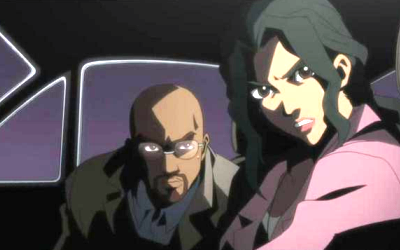
The third story actually tied this video as much to the Nolanverse as to the comics. We find a Morgan Freeman like Lucious Fox working in a Wayne Enterprises laboratory and interacting with Bruce Wayne. This story has the largest amount of our playboy, and actually tells how things led up to the gang war from the previous story. The artwork here comes across as very Asian, and Wayne is very reminiscent of the modern, child friendly series The Batman. He is extremely young and very showy. He playfully messes with a rich douche he golfs with, and then escalates the tension between two organized crime families. His decisions can almost be blamed for the circumstances that follow, and almost break character. In the afore mentioned comic series “War Games”, Batman intelligently played multiple gangs and the police against each other, where as in this short his decisions force additional confrontation between two rivals that don’t exhibit much intelligence.
Batman: The Animated Series alumni Jordan Goldberg, who helped in the writing for all the other segments, handles this one alone and surprisingly turns in one of the weaker stories. The name is field test and can be used to show how fearless Batman is as he tests out a bullet deflection device live in the field. While showing his bravery, it strays from the other stories and barely touches on the impact the Bat has on those around him.
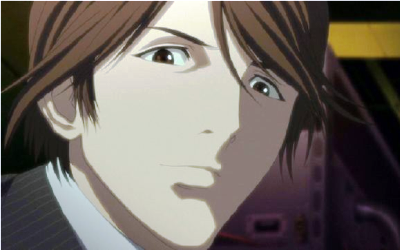
The fourth tale also has flaws and is written by a man known for his flawed writing, David S Goyer, one of the writers behind The Dark Knight and many of the plot gaps therein. This story should have easily been one of the grandest stories as it involves the biggest array of characters. We have Batman, Gordon, Allen and Ramirez against Killer Croc and the Scarecrow. Allen and Ramirez really don’t do anything, and it is never defined as to why Croc and Scarecrow were working together on a kidnapping. There are suggestions that Croc has been eating people, and it’s said that he has been gassed by Scarecrow, but it is never defined as to why and to what benefit was this done. Goyer has a history of irritating fans of the titles he touches, and this is no different. Goldberg may have had one of the weaker stories, but this is definitely just poor all over the place. Goyer had the keys to the kingdom, working with the largest of the rogue gallery in the anthology and he completely whiffs. The only thing this segment is good for is setting up for the next segment. The city animation is amazingly crisp in this segment, though the anatomy of the humans was very lacking in definition.
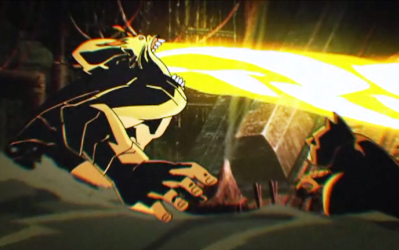
When we reach our last two stories, they continue to become more intimate with only a select few interacting for any decent amount of time. The penultimate chapter is written by another comic writer, Brian Azzerello. It deals more with Bruce than the Bat, and treads a theme that could easily fit into a prologue for Nolan’s Batman Begins. As Batman struggles to leave sewers and mend the injuries received in the previous tale, he reminisces about his training. It takes us to a time where a young Bruce watched cobra and mongoose fights while attempting to get a sect to train him. When he is forced to turn elsewhere, they mention he will be trained by a woman. My heart broke when that woman did not turn out to be Lady Shiva, but just someone skilled in pain management. Azzerello shows why his issues were well received by displaying multi-dimensional characters in such a short segment. The art has a soft edge, and as with the better segments of the video, the art matches the feel of the story.
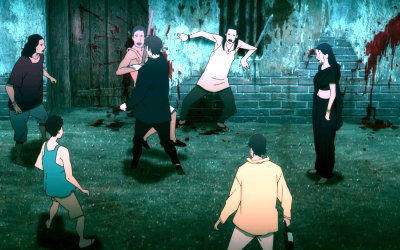
The last short finally brings in Alfred briefly, as well as Gordon and Allen both in quick but important roles. This segment was written by the team of Alan Burnett and Jordan Goldberg, both being Dini/Timm veterans and this time knocking it out of the park for an action packed finale. The only thing that doesn’t work in the story is the abruptness of the ending. The story deals with the mid-level bad guy, Deadshot. This is a character that is very similar to the Daredevil nemesis, Bullseye. He is a show off, an excellent marksman and rarely misses. The character doesn’t say much, but is the comic version of Raylon Givens from Justified. When he shoots he is deadly, and can be resourceful if needed. This is a character that was always primed for the big time, but with Batman having an already expansive and popular rogue gallery, he was never able to span that gap into the elite villains. This is the shortest story in the anthology, even though the story is the boldest in terms of visual style and action. The characters are all chiseled, and most look like an unreal engine rendered their character models. Ripped muscles and overly defined faces are complimented with a bright color palette and a grandiose scale.
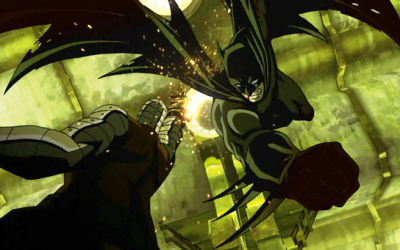
Is It Worth A Look: I find Gotham Knight to be a very mixed bad. While none of the stories are so bad they should be avoided, only two of the stories come across as much more than run time padding. The reason I recommend watching it comes from the weight it adds to the Batman mythology. If you want to watch a movie about Batman that deals with his effect on the city, this is that movie. As I said earlier, I would have fully committed to a Allen/Ramirez GCPD story, and even more so with the involvement of Rucka. Deadshot gets a great representation, easily displaying why not every film has to have the Joker or Two Face for Batman to work as a character. I found Deadshot to thrive in his short screentime, though Scarecrow and Croc are looked past due to their limited shared time in one over stuffed and weak segment.
The DCAU was in a transition phase when this movie came out, not committed to the future changes they were just beginning to make (comic book writers doing the screenplays and a new art development program) but also not willing to cut the ties between the Dini/Timm universe (almost all the voice talent and much of the writing was leftover from Batman: The Animated Series). They also never make a decision as to whether this universe is the same as the Nolanverse or the comics.
I’ve read enough Batman comics that a lot of the straight forward action tales don’t always keep me interested and I enjoy the dissection of the Batman character and those around him. This and Batman Beyond:Return of the Joker make me look past the main story and look at the expanded universe they take place in. Very few fictional characters have as big of a universe that the stories they are in can be just as entertaining as those that focus on everyone but them.
Random Anecdotes:
On the Commentary, fan favorite Batman actor Kevin Conroy admits that he never read anything about the Dark Knight until he auditioned in 1992.
Conroy had to get used to doing things opposite as they had been done on the TV show. The show went the traditional route and recorded the audio first and then matched the animation to it, while this movie matched the audio to the animation.
Cinematic Soulmates: Batman: Under the Red Hood, Batman: Mask of Phantasm, Batman Begins, The Dark Knight
